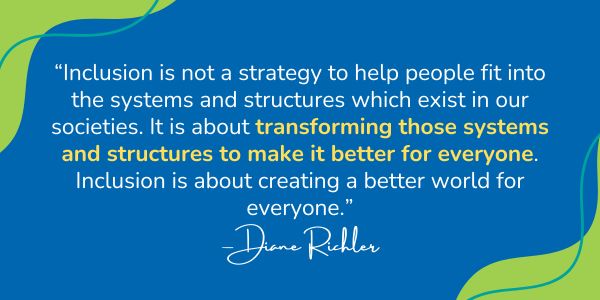 Disability Is Diversity
Disability Is Diversity
Inclusion is the intentional design of educational systems that provide ALL students equal access, opportunities, and a sense of belonging. A truly inclusive environment does not value one marginalized group over another; instead, it recognizes the unique backgrounds of all members of the community, including but not limited to cultural heritage, religion, socioeconomic status, sexual orientation, gender, disability, or any other differences. However, disability is often overlooked in inclusion efforts in the field of education, despite 15% of the K-12 student population across the country having a disability.
Individuals with disabilities often experience discrimination from multiple perspectives, as disability intersects with other marginalized identities. Not all disabilities are visible, often leading to assumptions about students’ abilities. To create awareness about disabilities, the implementation of inclusive programs is essential. Programs like these provide valuable opportunities for students to learn about diverse experiences, including those who live with disabilities, and help them develop a more empathetic understanding of the world. By exposing students to different perspectives, we encourage inclusive thinking and pave the way for greater inclusivity in future generations.
The Goal of Inclusion
Inclusion is a comprehensive framework that provides consistent and universal experience for all members of a learning community. The ultimate goal of inclusion is to ensure every student has the opportunity to engage, participate, feel appreciated, and be heard, regardless of their identity. It goes beyond merely acknowledging differences; it entails celebrating diversity in all forms to ensure students feel respected and valued for who they are.
Although inclusion may look different for each student, there are three main goals to strive for when appropriate:
- Place students in age-appropriate general education classes within their neighborhood school district.
- Provide high-quality instruction (with support as needed) to help them succeed in the core curriculum.
- Offer interventions and support to develop student self-advocacy skills and independence.
Students with disabilities represent a significant portion of the overall student population; how can we effectively promote an environment of genuine inclusion for all students?

The Inclusive Classroom
Creating an inclusive classroom acknowledges and accommodates the unique needs and abilities of all students. Intentional classroom design is focused on three main components of inclusion: academic, physical, and social.
Academic
Academic inclusion considers the removal of any barriers that may prevent students from accessing the content, participating in classroom activities, and demonstrating their knowledge. This may involve providing accommodations or modifications for students with disabilities, ensuring that instructional materials are culturally responsive, or offering alternative ways of demonstrating mastery of the content.
Physical
Physical inclusion is the intentional design of all places and spaces on a school campus that cater to the diverse needs of students. It involves exceeding the minimum ADA accessibility requirements, such as wheelchair ramps, elevators, and wide doorways. Instead, it consists of designing a space that supports learning and enables students to be successful for an extended period—for instance, providing flexible seating arrangements such as standing desks and beanbag chairs. Physical inclusion considers access to sensory tools such as fidgets to help students be successful in a sensory calm environment.
Social
Social inclusion fosters an environment where disabilities are seen as positive qualities instead of shortcomings and where teachers consider all students as their own. Encouraging participation in inclusive play and involving students in various activities provides opportunities for meaningful contributions.
This approach cultivates a learning community that:
- Creates a sense of belonging
- Provides all students with the ability to participate in the social experience
- Fosters a sense of community in which diversity is valued
- Ensures all students have a role
How All Students Benefit From Inclusion
Research suggests that inclusive education positively impacts all students, not just those who receive special education services. Studies have shown that inclusive classrooms:
- Improve Academic Success: A study conducted by Indiana University and published in the Journal of Special Education in 2022 found that high schools implementing inclusive classrooms have higher grades and are better prepared for secondary education and future jobs. Additionally, a 2016 study by Alana and ABT associates shows that inclusive classrooms support academic excellence for all students.
- Increase Confidence: Inclusive classrooms have benefits that go beyond academic achievement. They help students develop self-confidence and improve their social interactions with their peers. Instead of viewing differences negatively, inclusive classrooms celebrate diversity and promote acceptance of differences. They also provide all students with a better understanding of disabilities and differences.
- Develop a Sense of Community: Inclusive classrooms promote social and emotional development among students. By encouraging group activities and collaborative projects, students learn to communicate effectively and work together. This approach also helps them develop respect for each other’s differences. Creating a culture of acceptance and understanding fosters a sense of safety, and students can comfortably express themselves and share their thoughts and ideas.
- Provide Support and Access for All Students: In an inclusive classroom, teachers use a flexible teaching approach rather than a standardized one. They aim to create an environment where every student receives the support they need to succeed academically and develop the knowledge and skills required for success after graduation, regardless of their background or abilities.
Inclusion plays a vital role in promoting community and collaboration, which helps cultivate a supportive learning environment for ALL students. When schools embrace diversity and make efforts to foster a sense of belonging among their students, it creates an empowering learning environment where every student feels respected and included academically, physically, and socially.
